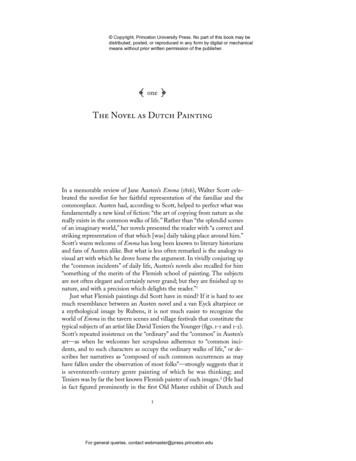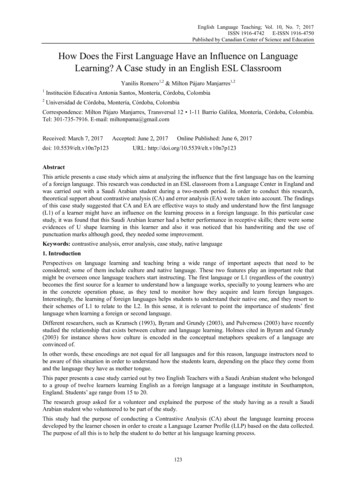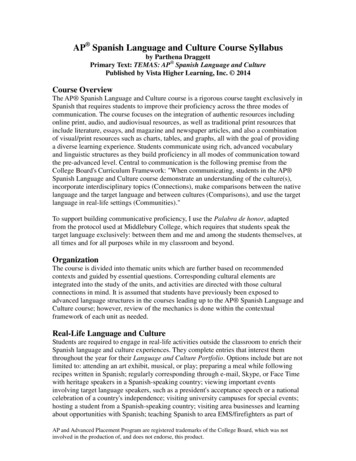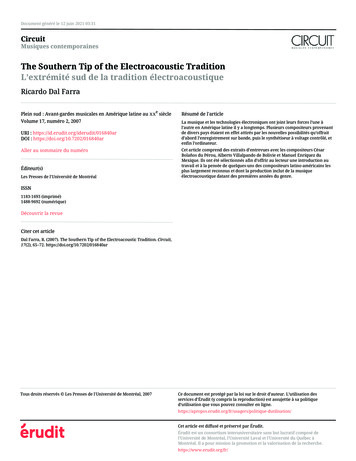
Transcription
DutchLanguage and CultureManualNational Language of the NetherlandsPrepared by:Laura Castaneda, B.S. &Lynsey Chalker, B.S.Texas State University-Class of 2012Academic AdvisorDr. Rahul Chakraborty
Dutch Language and Culture Manual 2Table of ContentsDutch StatisticsThe Netherlands‟ GeographyAbout the NetherlandsDemographics of the NetherlandsDistribution of Dutch Speakers in USDutch CultureRole of the FamilyDutch DemeanorDutch Cuisine.BreakfastTea TimeDinnerDutch DelicaciesDutch HolidaysLinguisticsPhonologyMorphologySyntaxCommon English Pronunciation ProblemsDunglishSocial and Pragmatic NormsGreetingsBusinessFood/GiftsOtherDutch Slang TermsSpeech-Language PathologistsWeb ResourcesTherapy/Test MaterialsResearch ArticlesCase History Template for Bilingual 232426
Dutch Language and Culture Manual 3Dutch StatisticsDutch is spoken by the 15 million inhabitants of the NetherlandsOfficial language of: Aruba, Belgium, Netherlands, Netherlands Antilles and Suriname.Spoken in: Netherlands, Belgium, Suriname, Aruba, Netherlands Antilles, South Africa,and Indonesia.Distribution of the Language:- Netherlands - 16,407,491(individuals)- Aruba - 5,289- Belgium - 4,620,150- United States - 412,637- Canada - 159,165- Germany - 101,000- France - 80,000- Australia - 47,955- Israel - 1,680- Suriname - 200,000- Netherlands Antilles - 4,000Dutch vocabulary has contributed many words to the English language. For example,yacht, easel, cookie, and freight all come from Dutch.Retrieved from: http://www.dutchlanguage.info/dutch/facts.asp
Dutch Language and Culture Manual 4The Netherlands’ GeographyWestern Europe, bordering the North Sea, between Belgium and GermanySlightly less than twice the size of New JerseyReferred to as Hollando Even though North and South Holland only make up 2 of the 12 provinceso Capital: AmsterdamRetrieved from: -factbook/geos/nl.htmlAbout the NetherlandsDutch, the official language, is spoken by around 90% of the population. Around 350,000people, or 2.2% of the population, speak Frisian as their first language, mainly in the northernprovince of Friesland, where it is recognized as an official language. Turkish and Arabic are alsospoken in the Netherlands, each by over 0.6% of the population.Retrieved from: tiquette/netherlands.html
Dutch Language and Culture Manual 5Demographics of the NetherlandsPopulationo 16,847,007 (July 2011 est.)Nationalityo Noun: Dutchman(men), Dutchwoman(women)o Adjective: DutchReligionso Roman Catholic 30%o Dutch Reformed 11%o Calvinist 6%o other Protestant 3%o Muslim 5.8%o other 2.2%o none 42% (2006)Ethnic Make-up:o Dutch 83%o Other 17% (of which 9% are non-Western origin mainly Turks, Moroccans,Antilleans, Surinamese and Indonesians) (1999 est.)Languageso Dutch (official)o Frisian (official)Literacyo Definition: age 15 and over can read and writeo Total population: 99%Retrieved from: -factbook/geos/nl.htmlDistribution of Dutch Speakers in the U.S.
Dutch Language and Culture Manual 6Dutch CultureThe Role of the Familyo The Dutch see the family as the foundation of the social structure.o Families tend to be small, often with only one or two children.o Relatively few women work outside the house full-time as compared to many othercultures.o This allows mothers to be more available to their children throughout the entire day.Dutch Demeanoro Appearances are important to the Dutch.o They are disciplined, conservative, and pay attention to the smallest details.o They see themselves as thrifty, hardworking, practical and well organized.o They place high value on cleanliness and neatness.o At the same time, the Dutch are very private people.o They do not draw attention to themselves and do not value the accoutrements ofsuccess highly prized by other western societies.o They dislike displays of wealth, as they run counter to their egalitarian beliefs.o They do not boast about their accomplishments or their material possessions.Dutch CuisineDutch Breakfasto Wide variety of cold cuts, cheeses and sweet toppings; such as hagelslag, vlokken andmuisjes.o Chocolate spread, treacle (a thick, dark brown sugar syrup called stroop), peanutbutter (which is savoury, not sweet) and confiture are popular too.o The Dutch are famous for their dairy products and especially for their cheeses. Thevast majority of Dutch cheeses are semi-hard or hard cheeses. Famous Dutch cheesesinclude Gouda, Edam, and Leyden.o A typically Dutch way of making cheese is to blend in herbs or spices during the firststages of the production process. Famous examples of this are cheeses with cloves(usually the Frisian nagelkaas), cumin (most famously Leyden cheese), or nettles.o Dutch bread tends to be very airy, as it is made from yeast dough. From the 1970sonward Dutch bread became predominantly whole grain, with additional seeds suchas sunflower or pumpkin seeds often mixed with the dough for taste. Rye bread is oneof the few dense types of bread of the Netherlands.o Those who do not want to have breakfast but need something on their stomach in themorning often eat the famous Dutch ontbijtkoek. It is usually served as a small slice,possibly with delicious rich Dutch butter.
Dutch Language and Culture Manual 7Tea Timeo Dutch people invite friends over for koffietijd (coffee time), which consists of coffeeand cake or a biscuit, served between 10 and 11 a.m. (before lunch) and/or between 7and 8 p.m. (after dinner)o The Dutch drink coffee and tea throughout the day, often served with a single biscuit.Dutch thrift led to the famous standard rule of only one cookie with each cup ofcoffee. It has been suggested that the reasons for this can be found in the Protestantmentality and upbringing in the northern Netherlands.o Café au lait is also very common. It is called koffie verkeerd (literally "wrong-wayround-coffee") and consists of equal parts black coffee and hot milk.o The Dutch drink tea without milk and the tea is quite a lot weaker than the typicalEnglish types of tea which are taken with milk. Other hot drinks used to include warmlemonade, called kwast (hot water with lemon juice), and anijsmelk (hot milk withaniseed).Dinnero Dinner, traditionally served early by international standards, starts at about 6 o'clockin the evening.o The old-fashioned Dutch dinner consists of one simple course: beans or potatoes,meat and vegetables. Traditionally potatoes with a large portion of vegetables and asmall portion of meat with gravy, or a potato and vegetable stew.o A typical traditional Dutch dinner would include stamppot (Dutch mashed potatomixed with other mashed vegetables) and pea soup. Vegetable stews served as sidedishes are for example rodekool met appeltjes (red cabbage with apples), or rodebieten (red beets).o Regular spices used in stews of this kind may be bayleaves, juniper berries, cloves,and vinegar. Stews are often served with mixed pickles, including zure zult (headcheese) or stewed pears (stoofperen). Due to the influx of other countries traditionalmeals have lost some popularity. Stamppot is traditionally eaten in winter.o If there is a starter, it is usually soup. The final course is a sweet dessert, traditionallyyoghurt with some sugar or vla, thin milk pudding (cooked milk with custard).Retrieved from: http://en.wikipedia.org/wiki/Dutch cuisine#Structure of mealsDutch Delicacies Poffertjes: mini pancakes, but thicker and sweeter. Often served with sugar and butter;popular with children.Stamppot: a winter dish with vegetables, potatoes and meat mashed together in onestew. There are varieties with kale, sauerkraut, onions, carrots, sausages and bacon. Thefinal touch is an indentation in the middle of the stew that is filled with gravy.
Dutch Language and Culture Manual 8 Snert: pea soup with sausages; another winter dish to help you reenergize. Patatje met: It‟s not the fries that are special, but what comes along with it. The Dutchprefer mayonnaise with their French fries instead of ketchup. Bitterballen: the best snack when sitting on a terrace with a drink. Small fried balls ofbeef ragout. The bigger brother of „bitterballen‟ is a kroket, which is sold at any snackcorner.Haring: the most popular fish in Holland is herring. Eat it on a bun with onions orpickles, or choose to do it the original way and have a bite while holding the fish in theair by its tail. Liquorice: Dutch liquorice is available both sweet and salty and in a wide range ofshapes and flavors.Hagelslag: chocolate sprinkles on a sandwich are enjoyed by young and old.
Dutch Language and Culture Manual 9 Muisjes: aniseed comfits eaten as bread topping and available with a pink, blue or whiteouter layer of sugar. It is a Dutch custom to eat rusk with aniseed comfits to celebrate thebirth of a baby Stroopwafel: a treacle waffle is a typical Dutch treat. This flat waffle is best enjoyedwith a cup of coffee or tea.Retrieved from: ion/AboutHolland/Progressive-Holland.htmDutch Holidays Public Holidayso New Year‟s Dayo Good Fridayo Eastero Queen‟s Dayo Liberation Dayo Ascension Dayo Whitsun Weekendo ChristmasJanuary 1April 22April 24 ,25April 30May 5June 2June 12, 13December 25, 26Queen‟s Day Honoring Queen BeatrixLiberation Day Marks the end of the occupation of Nazi Germany during WWIIAscension Day Bodily Ascension of Jesus into the HeavensWhitsun Weekend Name used in the UK for the Christian festival of Pentecost, the seventh Sundayafter Easter, which commemorates the descent of the Holy Spirit upon Christ'sdisciples
D u t c h L a n g u a g e a n d C u l t u r e M a n u a l 10LinguisticsPhonologyDutch spelling is basically phonemic where each grapheme must represent audible sounds orphonemes with a few exceptions. Dutch has 23 consonants (including allophones and marginalconsonants), 17 vowel sounds consisting of 14 monophthongs and 3 diphthongs and is mostclosely related to German. The alveolars /t, n/ are also palatalized before /j/. Unlike English, the/p, t, k/ are voiceless unaspirated, and the /b, d/ are fully voiced.There is considerable variation in the realization of the /r/ phoneme in Dutch (across dialects,sociolinguistic membership, styles, and phonological context). Some speakers use the voiceduvular fricative /χ/, others the uvular trill /ʀ/, alveolar trill /r/ or tap /ɾ/. In post-vocalic contexts/r/ in some dialects tends not to be realized.Devoicing of voiced fricatives is common in some dialects, so that /v/ is usually realized as /f/,/z/ is usually realized as /s/, and /ʒ/ is usually realized as /ʃ/. A glottal stop is often inserted beforevowel-initial syllables.Retrieved from: Garry, Jane, & Rubino, Carl. (Ed.). (2001). Facts about the world's languages:an encyclopedia of the world's major languages, past and present. New York & Dublin: A NewEngland Publishing Associates Book.Dutch AlphabetDutch has 27 letters, showed as follows:Retrieved from: http://www.dutchlanguage.info/dutch/alphabet.asp
D u t c h L a n g u a g e a n d C u l t u r e M a n u a l 11Other sounds: post-alveolar stops, fricatives, and nasals precede the palatal approximant; voicedbilabial fricative and aleolar approximant are variants in codas; voiced velar stops occur inloanwords; vowels may be long; diphthongs.Retrieved from:http://accent.gmu.edu/browse native.php?function detail&languageid 76MorphologyDutch has lost most if it‟s inflectional endings. The only morpheme that reflects case is thepossessive –s, applied to proper nouns, and some pronouns (i.e. Peters boek „Peter‟s book‟, mihnvaders pen „my father‟s pen‟, and ieders „everyone‟s).Number is reflected in nouns with various suffixes: -en, -s, -eren, and -ers.
D u t c h L a n g u a g e a n d C u l t u r e M a n u a l 12Nouns are divided into two classes: nouns with common gender that take the determiner de, andnouns with neuter gender that take the determiner het.Dutch has definite articles, indefinite articles, and demonstratives.Dutch verbs inflect for the present and past tense and the present and past participles. Finite verbforms agree with the person and number of the subject.Pronouns: have subject and object forms, both full and reduced. Reduced forms are commonlyused during speech while full forms are used for emphasis.Adjectives and adverbs: denoting gradual properties may take the comparative suffix –er (i.e.groter „bigger‟ vaker „more often‟) and the superlative suffix –st (i.e. grootst „greatest/biggest‟vaakst „most often).Retrieved from: Garry, Jane, & Rubino, Carl. (Ed.). (2001). Facts about the world's languages: anencyclopedia of the world's major languages, past and present. New York & Dublin: A New EnglandPublishing Associates Book.Morphology also concerns the way words are put together. Consider the following Dutch words:taal languagecursus coursedag dayThese are three separate Dutch words with their separate meaning. But we can also put these twowords together to form a new word. The resulting word is called a compound:taalcursus language coursecursusdag course day (i.e. a day in a course)These words can also be put together in a different order:dagcursus day coursecursustaal course languageThe first six words are all in the Dutch dictionary, but the last one, cursustaal, is not. It wascreated by combining already existing words into one. This is one of the most striking things ofhuman language. Language is productive. This means that you can „produce‟ new words andsentences that didn‟t exist before. Even though „cursustaal‟ is not in the dictionary it is still aperfectly grammatical word of Dutch and native speakers of Dutch will understand it, even ifthey have never heard it before.
D u t c h L a n g u a g e a n d C u l t u r e M a n u a l 13So what does the word mean? Note that „taalcursus‟ and „dagcursus‟ are both types of„cursussen‟ (courses). „Cursustaal‟, however, is a type of „taal‟ (language). It is said that theright-hand part of a word in Dutch is its head. This means that it is the most important part of theword, the one that determines its meaning. Consider the following list of Dutch compounds:cursustaal course languagespreektaal speaking languageschrijftaal writing languagetaalcursus language coursespreekcursus speaking courseschrijfcursus writing courseThe first three words are all types of „taal‟ (language) whereas the last three are all types of„cursussen‟ (courses). This is because of the right-headedness of Dutch compounds. The left partof the word tells you exactly what type of „taal‟ or „cursus‟ is meant.Retrieved from: http://www.dutch.ac.uk/studypacks/english language/linguistics/syntax.htmlSyntaxDutch is a verb-second language with nominative/accusative syntax. This is where subjects thatagree with the verbs can precede finite verbs in declarative sentences. However in questions,requests, and some exceptions in other sentence types, the verb is placed at the end of a clause.Like in the following sentence:Zal hij haar dat vertellen?Will he her“Will he tellthattellherthat?”This change in word-order does not occur in the English sentence, it is a unique feature of Dutch.Sentential negation is expressed by means of the adverb niet („not‟) or other negative words suchas geen, niemand, and niets.Retrieved from: Garry, Jane, & Rubino, Carl. (Ed.). (2001). Facts about the world's languages: anencyclopedia of the world's major languages, past and present. New York & Dublin: A New EnglandPublishing Associates Book.
D u t c h L a n g u a g e a n d C u l t u r e M a n u a l 1427 Common English Pronunciation ProblemsENGLISHSOUNDFIX PROBLEM-COMMONERROR-Voiced. Friction with topteeth & bottom lip./v/"van"/f/"fan"Move front of tongue alittle higher./e/"set"/æ/"sat"Move tongue to a lowerfront position./æ/"man"/e/"men"Keep mouth round andtongue back./ɒ /"not"Back of tongue high. Lips /ʊ /rounded but relaxed. Short."full"/u:/"fool"Tongue low central. Lipsrelaxed./ʌ /"cup"Drop tongue to makemouth a little deeper./ʌ /"London" (1stsyllable)/ə/"London" (2ndsyllable)/ɜ :/"bird"Start with tongue not solow./eɪ /"late"/aɪ /"light"Don't make last part toostrong./ɔ ɪ /"boy"Tongue central. Thentightly round lips./əʊ /"note"/ɒ /"not"Start with lips tightlyrounded. Unround./ʊ ə/"tour"Relax the mouth and keepsound short./ɪ /"sit"/i:/"seat"Tongue low front. Thenround & unround lips./aʊ ə/ /aʊ / /ə/"flour"/v/"vest"/d/"day"Fix tongue in centralposition. Long.Start with lips tightly/w/rounded. Unround & glide."west"Voiceless. Friction. Tongue /θ/between teeth."thin"Voiced. Friction. Tonguebetween teeth."they"/ð/
D u t c h L a n g u a g e a n d C u l t u r e M a n u a l 15ENGLISHSOUNDFIX PROBLEM-COMMONERROR-Voiced. Friction. Tonguebetween teeth./ð/"clothe"/z/"close" /z/Tip of tongue behind topteeth./d/"made"/t/"mate"Voiced: tip of tonguebehind top teeth. Friction./z/"rise"/s/"rice"Voiceless. Friction. Frontof tongue to palate./ʃ /"push"/ʃ /"Confucian"Voiced: Front of tongue to /ʒ /palate. Friction."confusion"Unvoiced: Tip to alveolar. /ʧ /Front to palate."cherry"Voiced: Tip to alveolar.Front to palate./ʤ /"wage"Voiced stop: back oftongue to back roof./ŋ/ /g/"thing"/ŋ/ /k/"think""survivor"/r/"Sir Ivor"British "r" is weaker &silentusually silentunless followed by a vowel.Tongue low front to highfront to centre./aɪ ə/ /aɪ / /ə/"fire"Retrieved from: http://www.btinternet.com/ ted.power/l1dutch.html“Dunglish”“Dunglish” or Dutch English are the mistakes native Dutch speakers make when speakingEnglish; a combination of Dutch and English.Incorrect Meaning of WordsErrors often occur because of the false friend or false cognate possibility: words are incorrectlytranslated for understandable reasons. Examples are:Former prime-minister Joop den Uyl once remarked that "the Dutch are a nation ofundertakers". The Dutch verb ondernemen is literally the English undertake (as onder isunder and nemen is take). The noun ondernemer is thus literally undertaker; however the
D u t c h L a n g u a g e a n d C u l t u r e M a n u a l 16idiomatic English usage is instead the French loanword entrepreneur. (Dutch uses themore specific begrafenisondernemer for a funeral director.)In spring during the Second World War, Churchill said to former prime-ministerGerbrandy while the two were standing on a balcony: "Spring is in the air". Gerbrandy'sresponse was: "Why should I?" Gerbrandy thought Churchill told him: "Spring 'ns in delucht", which translates into English as: "jump into the air".One of the best known examples of Dunglish took place between the Dutch foreignminister Joseph Luns and John F. Kennedy. At one point Kennedy inquired what hobbyLuns had, to which he replied "I fok horses". The Dutch verb fokken meaning to breed.Kennedy then replied "Pardon?" a word which Luns then mistook as the Dutch word for"horses" ("paarden") and enthusiastically responded "Yes, paarden!"Word OrderSome Dutch speakers may use Dutch syntax inappropriately when using English, creating errorssuch as What mean you? instead of What do you mean?This is because English and Dutch do not follow exactly the same word order. English has aSVO word order, but Dutch has this word order only partially having a V2 word order. Usedwith modal auxiliaries, Dutch perfect participles are placed at the end of a phrase.Verb ConjugationEnglish and Dutch are both West Germanic, with many cognate verbs with identical or nearlyidentical meanings. This similarity between verbs may cause speakers of Dutch to conjugateEnglish verbs according to Dutch grammar.We kisse(n) her. (Dutch kussen means and is cognate with English to kiss. In Dutch grammar,verbs with plural subjects take a form identical to the infinitive, which in most cases has an ensuffix.)What do you now? for What are you doing right now? (In Dutch, Wat doe je nu?)How goes it now? for How are you doing now? (The phrase is used particularly after someonehas had a bad spell. A similarly constructed phrase is found in Shakespeare, carrying a slightlydifferent meaning, which underlines the even closer similarities between English and Dutchhistorically.)
D u t c h L a n g u a g e a n d C u l t u r e M a n u a l 17English employs periphrastic constructions involving the verb to do for forming questions, a rarefeature cross linguistically. Dutch does not use this construction, but instead utilizes a VSO wordorder, inverting the subject and verb.Errors in PronunciationWords like “third” and “the” are commonly mispronounced by Dutch speakers as “turd” and“duh”, replacing the dental fricative consonants that are not present in Dutch with dentalplosives, the nearest equivalent.Many Dutch speakers have trouble distinguishing between bat, bad, bet and bed. This is becauseDutch devoices obstruents at the end of a word, and also because Dutch does not distinguishbetween [æ] and [ɛ ].Some pronounce the word idea (in Dutch: idee) without the ending sound, making "Do you havean idea?" and "Do you have an ID?" sound the same.Other IndicationsUsing greetings to end an email as a literal translation of (met vriendelijke) groeten - in English;however, a greeting is usually to describe the start of an exchange and it is odd to use it at theend. Note also that greeting is generally used in English only to describe the act of welcomingsomeone into your house, usage in text as a form of salutation is restricted to Christmas cards(Season's Greetings) and would always be used at the start (never at the end).Using possessive forms like that is the Lamborghini of Patrick instead of the use of anapostrophe to indicate possession. Saying that Lamborghini is Patrick's is a markedimprovement, and a native English speaker would say that is Patrick's Lamborghini.Concatenation of words like office manager is a common Dutch habit that sometimes alsocreates unintended misinterpretation.Excessive and incorrect use of the apostrophe particularly when using acronyms in the pluralform - note however that this is quite common in many countries including the US.Over translationCertain Dutch users have a tendency to over translate Dutch terms causing a literal, sometimesunintelligible, translation of the Dutch term into English. For example the English and Dutchknow the famous Amsterdam church as the Westerkerk. The term "Western Church" used to helpEnglish tourists locate this tourist attraction can cause more confusion than necessary. (However,English users have readily adopted "Dam Square" instead of "Dam", the original form of thisAmsterdam open space.)
D u t c h L a n g u a g e a n d C u l t u r e M a n u a l 18Over translation can yield some misinterpretation in the language.Retrieved from: http://en.wikipedia.org/wiki/DunglishSocial and Pragmatic NormsThings to remember when interacting in a formal or clinic setting:Greetings:It is normal to shake hands even for ladies. It is a common form of greeting. It is alsonormal to shake hands while leaving. Shake hands with everyone individually includingchildren.Please introduce older people first, as it is a sign of respect.Do stand when someone is being introduced to you.Greet people upon coming and leaving.Do kiss three times on alternating cheeks (left, right, left) when greeting someone as wellas bidding farewell. This is a custom typically for people of the opposite sex, althoughsome people of the same sex do this as well. Familiar business partners also greet eachother in that fashion. Even if you feel uncomfortable partaking in this greeting, youshould go along with it because it could be seen as insulting if you refuse.Business:There‟s not much room for chitchatting; shake hands, introduce yourself and talkbusiness. Often you‟re immediately called by your surname or first name, even if you‟rein chargeThe Dutch are known for being straightforward (which is sometimes experienced asrudeness) and there isn‟t a single topic that cannot be discussed in an informal setting.The only thing that is not done is to ask a Dutch acquaintance how much he or she earns.Do not assume that the person is being rude if they do not use manners. They may notknow them in English or not know our customs.Food/Gifts:Unless you were invited to a meal and the host told you that it was their treat, you shouldpay your portion of the bill or expect the bill to be divided up evenly.In Holland, it is a custom to bring along a present, not only to a birthday, but also whenyou‟re invited for dinner to someone‟s house. This could be a book, flowers, chocolatesor bottle of wine. If you receive a present, you‟re expected to unwrap it straight away.Breakfasts are often skipped, lunch is a simple meal of bread, dairy products and fruit,and dinner is mostly potatoes, vegetables and a piece of meat. Coffee and tea are enjoyedthroughout the day.Other:Refer to the Netherlands as “The Netherlands.”
D u t c h L a n g u a g e a n d C u l t u r e M a n u a l 19Don‟t tap the center of your forehead with your index finger. It's the sign for "crazy" andis considered an impolite gesture.Retrieved from: utHolland/Progressive-Holland.htmlDutch Slangbrugpieper: a pupil in the lowest class of a lyceum. The word is used by pupils in thehigher classes. It is a composition of "brugklas" (bridge-class; the first class being a"bridge" to different types of secondary education) and "pieper" (pipit, young chicken).buffelen: to work very hard. Apparently this word is derived from "buffel" (buffalo),referring to the domesticated buffaloes that plough rice-fields.dombo: dumbo, idiotflikken: to do. "Hoe heb je dat geflikt?" meaning "How did you manage to do that?"Johny (noun, male: A non-intellectual male person note Pejorative use of the male firstname once popular in Dutch working class. Also 'Johnny' or 'Sjonnie'. Often used inconjunction with its female equivalent 'Anita'.knor: someone who gets everything wrong, always says the wrong things at the wrongmoments, and is therefore considered a social failure note This word is widely used instudent communities, and is known to all former students as well. Example: 'John is eensuffe knor!' means as much as 'John is a boring, uninteresting person'.muts: girl. Mostly used for girls over 16.publiciteitsgeil: Extremely keen on publicity. Mostly applied to politicians and artists.The literal meaning is "publicity-horny".tongzoen: a French kiss. This word means simply "tongue-kiss".vackman: a skilled worker. Tell this to your boss if he lets you sweep the floor!!!zeiker: Someone who complains about trivial matters of things that cannot be changed.Retrieved from: http://www.dutchlanguage.info/dutch/slang.asp
D u t c h L a n g u a g e a n d C u l t u r e M a n u a l 20Dutch Speech-Language Pathologists and AudiologistsFor more information or additional speech-language pathologists and audiologists please visithttp://www.asha.org/proserv/Speech Language PathologistsUnited StatesProgressivEdge1050 Pipeline RdHurst, TX 76053Director: Ronda PolanskyPhone: 800-989-6241Email: scarp98@juno.comFacility Type: Outpatient Rehab Center; Swallowing DisordersPayment Type: Medicare, Medicaid, Health InsuranceThe NetherlandsDutch Association of Voice, Speech and Language Pathology (NVSST)Prof. H.K. SchutteENT ClinicUniversity Hospital, PO Box 30.001NL-9700 RB Groningen, NetherlandNederlandse Verening voor Logopedie en Foniatria (NVLF)Oosthaven 38 Postbus 3088, 2800 CD GOUDAPhone: 31/182 587188Fax: 31/182 517655Website: www.nvlf.nlEmail: logopedie@nvlf.nl
D u t c h L a n g u a g e a n d C u l t u r e M a n u a l 21Web ResourcesDutch CuisineWebsite Name: Traditional Dutch RecipesWebsite oking/u/TraditionalDutchFood.htmWebsite Name: Food and Drink in the NetherlandsWebsite Address: d/food.aspWebsite Name: Dutch RecipesWebsite Address: http://www.food.com/recipes/dutchWebsite Name: Move to NetherlandsWebsite Address: http://movetonetherlands.com/recipes.htmlDutch LanguageWebsite Name: The Speech Accent Archive-DutchWebsite Address:http://accent.gmu.edu/browse language.php?function find&language dutchWebsite Name: Dutch LanguageWebsite Address: http://www.dutchlanguage.info/Website Name: Dutch Language Learning GamesWebsite Address: http://www.digitaldialects.com/Dutch.htmWebsite Name: Dutch Language, Alphabet, and PronunciationWebsite Address: http://www.omniglot.com/writing/dutch.htmWebsite Name: Dutch Language ActivitiesWebsite Address: lWebsite Name: The Dutch LanguageWebsite Address: bsite Name: Dutch Dialects
D u t c h L a n g u a g e a n d C u l t u r e M a n u a l 22Website Address: tch HistoryWebsite Name: Dutch-The Canadian EncyclopediaWebsite ex.cfm?PgNm TCE&Params A1ARTA0002476Website Name: A Brief Outline of Dutch History and the New Netherland ColonyWebsite Address: erlands.htmlWebsite Name: Dutch HistoryWebsite Address: htmWebsite Name: Dutch History and CultureWebsite Address: http://www.livius.org/holland.htmlWebsite Name: Netherlands HistoryWebsite Address: http://www.infoplease.com/ipa/A0107824.htmlDutch TraditionsWebsite Name: Move to NetherlandsWebsite Address: http://www.movetonetherlands.com/typical dutch.htmlWebsite Name: Netherlands-The People and the CultureWebsite Address: therlands.phpWebsite Name: A Quick 101 in Dutch Customs and TraditionsWebsite Address: http://www.jandaljourneys.com/a-quick-101-in-d
Dutch, the official language, is spoken by around 90% of the population. Around 350,000 people, or 2.2% of the population, speak Frisian as their first language, mainly in the northern province of Friesland, where it is recognized as an offici










